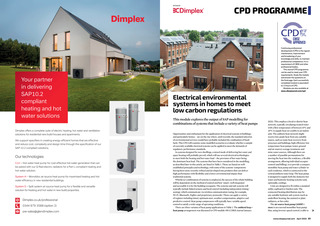


SPONSOR CPD PROGRAMME Continuing professional development (CPD) is the regular maintenance, improvement and broadening of your knowledge and skills, to maintain professional competence. It is a requirement of CIBSE and other professional bodies. This Journal CPD programme can be used to meet your CPD requirements. Study the module and answer the questions on the final page. Each successfully completed module is equivalent to 1.5 hours of CPD. Modules are also available at www.cibsejournal.com/cpd Electrical environmental systems in homes to meet low carbon regulations This module explores the output of SAP modelling for combinations of systems that include a variety of heat pumps Opportunities and enthusiasm for the application of electrical systems in buildings and particularly homes are on the rise where, until recently, the standard selection of environmental services would have probably included the combustion of fossil fuels. This CPD will examine some modelled scenarios to evaluate whether a sample of currently available electrical systems can be applied to meet the demands of regulatory performance standards. In systems designed for new dwellings, a mixed mode of delivering hot water and space heating will probably prevail, which will use several electrical technologies to meet both the heating and hot water load the provision of hot water being the dominant heat load. The systems that have been considered in the modelling, as described later in this article, are listed in Table 1. These are based on wellestablished principles and technology, with some of the systems components having been more recently refined and developed into products that can deliver high performance with flexibility and a lower environmental impact than traditional systems. Whichever combination of systems is employed, the success of the whole building will be dependent on the method of control and how smart, well integrated and accessible it is for the building occupants. The systems and sub-systems will typically include linked sensors and local control (including independent timing/ zoning), which communicate via wireless communication (using, for example, Wi-Fi, Bluetooth, ZigBee and proprietary protocols). These can apply a variety of regimes including timed, optimum start, weather compensation, adaptive and predictive control. Heat pump compressors will typically have variable speed control to satisfy a wide range of operating conditions. There are three variants of heat pump applications in Table 1. The ambient loop + heat pump arrangement was discussed in CPD module 190 (CIBSE Journal January 2021). This employs a local or district heat network, typically circulating treated water with a flow temperature of between 15C and 25C to supply heat (or coolth) to an indoor unit. The ambient heat network might receive low-grade heat from any suitable source, such as waste heat recovery from processes and buildings; high efficiency low temperature heat pumps (water, ground and air source); sewage treatment; and mine water sources. Although there are a number of possible permutations for moving the heat into the residence, a flexible arrangement, allowing individual occupier control (and billing), is to provide a compact monobloc heat pump and water cylinder in each residence, which is connected to the central ambient water loop. The heat pump is designed to supply both the domestic hot water and hydronic heating systems (and, optionally, cooling). Units are designed to fit within a standard utility cupboard or kitchen unit. The connected heating distribution may be any suitable hydronic sub-system (such as underfloor heating, fan assisted or plain radiators, or fan coils). The air source heat pump (ASHP) + store is an external monobloc heat pump that, using inverter speed control, is able to www.cibsejournal.com April 2023 61